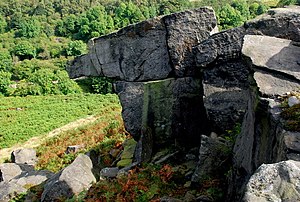Gibbet Moor
| Gibbet Moor | |||
| Derbyshire | |||
|---|---|---|---|
 Rock outcrop on Gibbet Moor | |||
| Range: | Peak District | ||
| Summit: | 968 feet SK300681 53°13’50"N, 1°34’32"W | ||
Gibbet Moor is a small gritstone upland area in the Derbyshire Peak District, near the village of Baslow. Its highest point is 968 feet above sea level.
The Chatsworth Estate lies to the west and Umberley Brook run along the moor's east edge. East Moor is the broader moorland area covering Gibbet Moor, Brampton East Moor and Beeley Moor.
Gibbet Moor is a prehistoric landscape with several protected Scheduled Ancient Monuments.[1]
The moor was in past ages the site of a gibbet, a wooden structure like a gallows, where the dead bodies of criminals were hung on display. This gibbet was used on the last occasion a person was gibbeted alive in Britain: a vagrant who was begging for food around Baslow and killed a woman in her cottage. The murderer was left to die in a gibbet cage on Gibbet Moor in the 17th century.[2]
Prehistoric landscape
A widespread Bronze Age settlement covers a stretch of moorland over 1km long. The complex includes a stone circle, more than 250 cairns, cemeteries of burial mounds (barrows) and remains of field enclosures and building platforms of probable farmhouses. The stone circle has an outer ring of standing stones about 30 feet in diameter, with an inner square of standing stones (with three of the "four poster" stones remaining).
The historic landscape has been modified by Second World War training exercises. The site today is a Scheduled Monument.[3]
To the west of the large prehistoric settlement is another cairnfield and field system, which is a separate Scheduled Monument. This formed part of the same Bronze Age cultivation landscape but was separated by more recent land enclosures.[4]
A Bronze Age cairn cemetery on the eastern edge of the moor is a further Scheduled Monument. The largest cairn is 30 feet long with at least seven other cairns nearby.[5]
Hob Hurst's House is an unusual square Bronze Age burial cairn on Harland Edge (between Gibbet Moor and Beeley Moor). Thomas Bateman excavated the barrow in 1853 and discovered a stone cist containing cremated remains. It has been a protected national monument since 1882.[6]
Enclosure and access
Until 1824 Gibbet Moor was common land and then the Enclosures Act allocated the land of Gibbet Moor to the Duke of Rutland. In an exchange of lands, the 6th Duke of Devonshire acquired the 652 acres of Gibbet Moor to extend his Chatsworth Estate to the east.[7]
Gibbet Moor became "Open Access" land for the public, following the Countryside and Rights of Way Act 2000.[8]
The Peak District Boundary Walk runs along the track on the west side of the moor.[9]
References
- ↑ "The List Search Results for Gibbet Moor" (in en). https://historicengland.org.uk/listing/the-list/results/?searchType=NHLE+Simple&search=Gibbet+Moor.
- ↑ Priestley, Samantha (2020-03-30) (in en). The History of Gibbeting: Britain's Most Brutal Punishment. Pen and Sword History. pp. 7-9. ISBN 978-1-5267-5521-6. https://books.google.com/books?id=_9vdDwAAQBAJ&pg=PA8.
- ↑ National Heritage List 1019000: Bronze Age settlement and ceremonial remains on Gibbet Moor, north east of Swiss Cottage (Scheduled ancient monument entry)
- ↑ National Heritage List 1018999: Cairnfield and field system east of Park Gate Farm (Scheduled ancient monument entry)
- ↑ National Heritage List 1019906: Cairn cemetery on Gibbet Moor, south west of Stonelow Farm (Scheduled ancient monument entry)
- ↑ National Heritage List 1008600: Hob Hurst's House: a square, banked and ditched burial cairn with cist on Harland Edge (Scheduled ancient monument entry)
- ↑ "Baslow in the 1820s". http://places.wishful-thinking.org.uk/DBY/Baslow/Baslow1820s.html.
- ↑ "CRoW and Coastal Access Maps". http://www.openaccess.naturalengland.org.uk/wps/portal/oasys/maps/MapSearch/.
- ↑ McCloy, Andrew (2017). Peak District Boundary Walk: 190 Miles Around the Edge of the National Park. Friends of the Peak District. ISBN 978-1909461536.